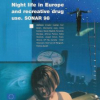Enjoying the Nightlife Europe
Recreational nightlife in Europe is diverse and complex. This study explores the behaviour and beliefs of young people who participate in recreational life whilst choosing not to use substances or to do so only occasionally and moderately.
The research is empirically based. Statistical and ethnographic data have been collected from a sample of 1,777 young people who were interviewed in recreational environments across ten European cities.
The analyses focus on key issues in the relationship between young people and drug consumption including: gender differences, risk perception, management of finances, leisure, free time, prospects, control of risk and sexuality.
We hope that this work will contribute to the development of new strategies for creating healthier attitudes among young people by enabling greater levels of independence and personal autonomy.
| Categorie: | Uitgaansdrugs en veilig uitgaan |
| Bestandsgrootte: | |
| Bestandstype: | |
| Aanmaakdatum: | 05-20-2021 |
| Datum laatste update: | 05-20-2021 |





